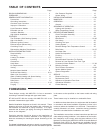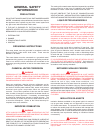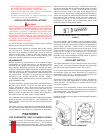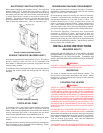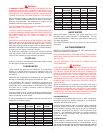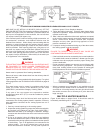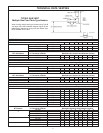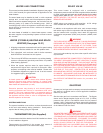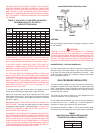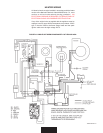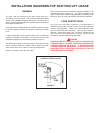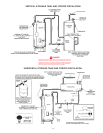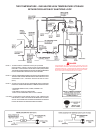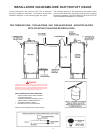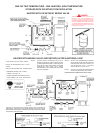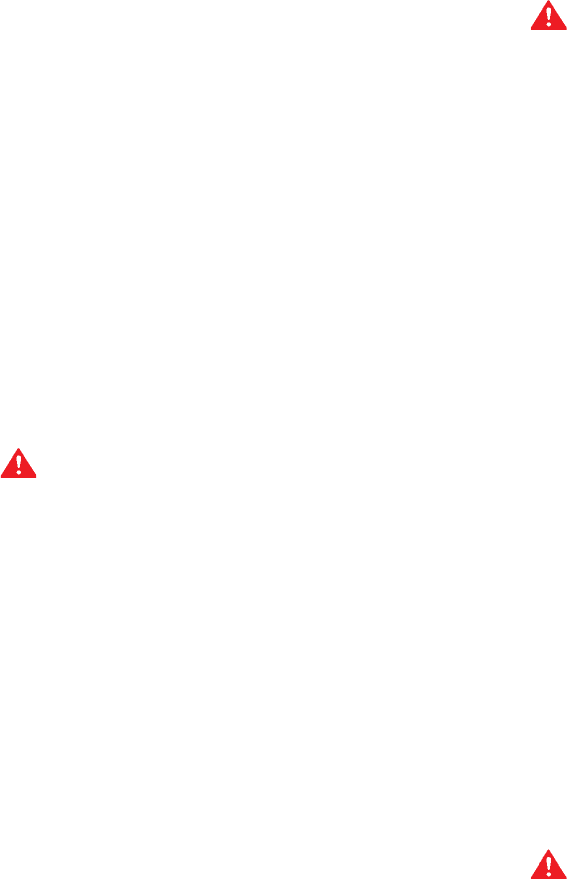
11
WATER LINE CONNECTIONS
This manual provides detailed installation diagrams (see pages
15-21 of this manual) for typical methods of application for the
water heaters.
The water heater may be installed by itself, or with a separate
storage tank, on both single and two-temperature systems.
When used with a separate storage tank, the circulation may be
either by gravity or by means of a circulating pump. When a
circulating pump is used it is important to note that the flow rate
should be slow so that there will be a minimum of turbulence
inside the heater.
If a water heater is installed in a closed water system, contact
the water supplier or local plumbing inspector on how to control
this situation.
WATER (POTABLE) HEATING AND SPACE
HEATING (See pages 15-21)
1. All piping components connected to this unit for space heating
applications shall be suitable for use with potable water.
2. Toxic chemicals, such as those used for boiler treatment,
shall NEVER be introduced into this system.
3. This unit may NEVER be connected to any existing heating
system or component(s) previously used with a non-potable
water heating appliance.
4. When the system requires water for space heating at
temperatures higher than required for domestic water
purposes, a tempering valve must be installed. Please refer
to installation diagrams on pages 16 and 18 of this manual
for suggested piping arrangements.
CAUTION
A closed system will exist if a check valve (without bypass),
pressure reducing valve (without bypass), or a water meter
(without bypass) is installed in the cold water line between the
water heater and street main (or well).
Excessive pressure may develop in such closed systems,
causing premature tank failure or intermittent relief valve
operation.
This is not a warranty failure. An expansion tank or a
similar device may be required in the inlet supply line between
the appliance and the meter or valve to compensate for the
thermal expansion of the water.
SYSTEM CONNECTIONS
The system installation must conform to these instructions and
to the local code authority having jurisdiction. Good practice
requires that all heavy piping be supported.
THERMOMETERS (Not Supplied)
Thermometers should be obtained and field installed as shown
in the installation diagrams.
Thermometers are installed in the system as a means of
detecting the temperature of the outlet water supply.
RELIEF VALVE
This water heater is equipped with a combination
temperature-pressure relief valve that complies with the standard
for relief valves and automatic gas shutoff devices for hot water
supply system, ANSI Z21.22. FOR SAFE OPERATION OF THE
WATER HEATER, THE RELIEF VALVE(S) MUST NOT BE
REMOVED OR PLUGGED.
ASME ratings cover pressure relief capacities. A.G.A. ratings
cover release rate with temperature actuation.
In addition to the appliance relief valve, each remote storage
tank which may be used in conjunction with this appliance shall
also be installed with a properly sized, rated and approved
combination temperature (ANSI) and pressure (ASME) relief
valve(s).
WARNING
THE PURPOSE OF RELIEF VALVE IS TO AVOID EXCESSIVE
PRESSURE OR TEMPERATURE INTO THE STEAM RANGE,
WHICH MAY CAUSE SCALDING AT FIXTURES, TANK
EXPLOSION, SYSTEM OR HEATER DAMAGE. NO VALVE IS TO
BE PLACED BETWEEN THE RELIEF VALVE AND TANK.
Your local code authority may have other specific relief valve
requirements.
A DRAIN LINE MUST BE CONNECTED TO THE RELIEF VALVE
TO DIRECT DISCHARGE TO A SAFE LOCATION TO AVOID
SCALDING OR WATER DAMAGE. THIS LINE MUST NOT BE
REDUCED FROM THE SIZE OF THE VALVE OUTLET AND MUST
NOT CONTAIN VALVES, RESTRICTIONS NOR SHOULD IT BE
LOCATED IN FREEZING AREAS. DO NOT THREAD OR CAP
THE END OF THIS LINE. RESTRICTED OR BLOCKED
DISCHARGE WILL DEFEAT THE PURPOSE OF THE VALVE AND
IS UNSAFE. DISCHARGE LINE SHALL BE INSTALLED TO
ALLOW COMPLETE DRAINAGE OF BOTH THE VALVE AND LINE.
See SERVICE INFORMATION section for procedure and
precautions.
GAS PIPING
Contact your local gas service company to ensure that adequate
gas service is available and to review applicable installation
codes for your area.
Size the main gas line in accordance with Table 6. The figures
shown are for straight lengths of pipe at 0.5 in. W.C. (0.12kPa)
pressure drop, which is considered normal for low pressure
systems. Note: Fittings such as elbows, tees and line regulators
will add to the pipe pressure drop. Also refer to the latest version
of the National Fuel Gas Code.
WARNING
THE HEATER IS NOT INTENDED FOR OPERATION AT HIGHER
THAN 14.0" W.C.(3.48Kpa) - NATURAL GAS, 14.0" W.C.(3.48Kpa)
- PROPANE GAS (1/2 POUND PER SQUARE INCH GAGE-3.45
kPA) SUPPLY GAS PRESSURE. EXPOSURE TO HIGHER
SUPPLY PRESSURE MAY CAUSE DAMAGE TO THE GAS VALVE
WHICH COULD RESULT IN FIRE OR EXPLOSION. IF
OVERPRESSURE HAS OCCURRED SUCH AS THROUGH
IMPROPER TESTING OF GAS LINES OR EMERGENCY



